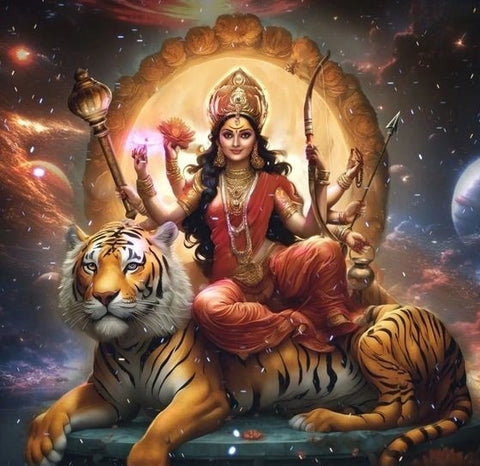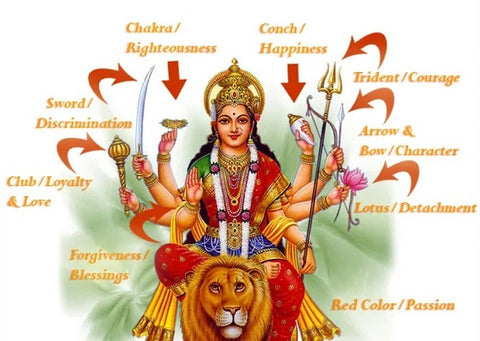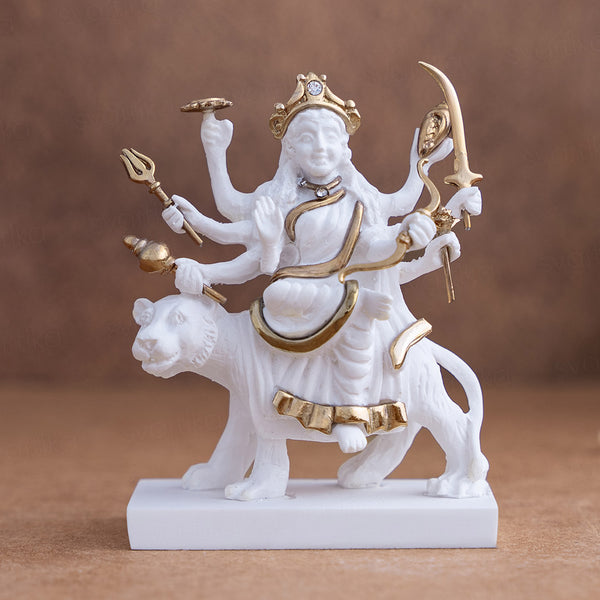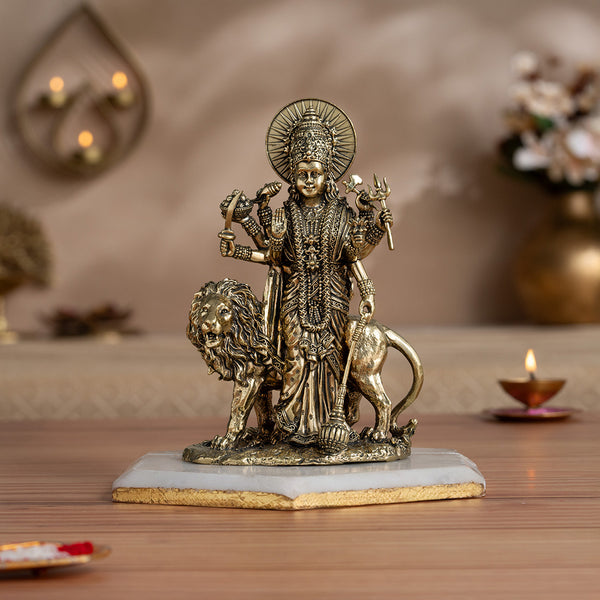Being born a Hindu, comes with colorful flowers, sweets made in abundance, and diyas being lit in every crevice of our homes.
It comes with temple outings, chanting the name of our favourite God during times of need, and a kumkum box that never runs out.
Being a Hindu is not something I can hope to even condense into a mere few sentences, but we, at Svastika, try our best.
Our Hindu mythology is woven with the legendary tales of Gods, the ultimate battle of good versus evil, that always triumphs with righteousness winning, every single time, but my favourite stories growing up were of the grace, penance, sacrifice, humility, and the blinding rage of Goddess Durga.
The mother of all Goddesses, her stories never fail to amaze, portraying her as a character larger than life, with her blazing eyes, innumerable limbs, and sheer power that seemed to crackle out of her very essence.
Often referred to as the Divine Mother, is believed to personify the ultimate feminine power.
Her form is a magnificent fusion of grace and might, with multiple arms bearing symbolic weapons and tools, each representing her various aspects.
She is the protector of the righteous, the destroyer of evil, and the embodiment of courage.
The Profound Significance of Durga’s Multifarious Arms
If you are asked to picture Goddess Durga, the image comes in hues of red, with her big, angry eyes, expression of rage, her ten arms bearing different instruments of power and destruction.
This is the portrayal of Goddess Durga that we are most familiar with, where her rage overpowers even that of Lord Shiva.
Goddess Durga's numerous arms serve as a potent symbol of her boundless strength and divine prowess.
How can an angry God not frighten mere mortals, and one with myriad limbs stand as a testament to Goddess Durga's fierceness and raw power.

A warrior goddess who fearlessly combats the adversaries of the divine realm.
Intriguingly, however, in certain traditions, each of these arms is linked to an incarnation of Durga, encapsulating the multifaceted nature of her divine presence.
This is a symbolic representation that is believed to stand as a reminder of the multitude of times she emerged victorious over demons and evil entities.
Each of her arms cradles symbolic weapons and tools, each with its own unique meaning. Together, they paint a vivid picture of her cosmic persona.
Goddess Durga, also lovingly known as the Divine Mother, perfectly balances grace and power.
How Many Hands Does Durga Actually Have? Unveiling the Diversity in Depictions
Goddess Durga is a formidable force, touted as the goddess of strength and courage, she is often depicted with a varying number of arms, adding to the mystique that surrounds her.
A question that often raises in the minds of her devotees, with some stories mentioning it as ten, whilst others have it as an uncountable number.

While the most common portrayals feature her with either 8 or 10 arms, some representations go beyond, reaching counts of 12, 16, 18, or even an awe-inspiring 20 arms.
The 8-armed version of Goddess Durga is believed to be a representation that resonates with her warrior aspect, symbolizing her role as the destroyer of evil forces.
On the other hand, pun-intended, the 10-armed rendition ties back to her incarnation as Mahishasura Mardini, the slayer of the buffalo demon Mahishasura.
Interestingly, some other Mahavidyas like Bhuvaneshvari or Matangi may sport 12 or 14 arms in their depictions.
However, the exact number of arms can vary, as the emphasis lies more on their symbolic significance than the precise count.
Furthermore, the differences in the geographical areas also directly connect to these depictions.
Goddess Durga's multifaceted nature finds expression through these varying arm counts, enriching her character and allowing devotees to connect with her diverse aspects.
Unveiling the Profound Significance of Durga's Divine Arsenal
The visual spectacle of Goddess Durga, resplendent with her blazing eyes and numerous limbs, radiates an aura of sheer power that seems to emanate from the very core of her being.
These arms, like extensions of her divine will, affirm her status as the ultimate manifestation of feminine strength and resilience.
Goddess Durga's ten arms are adorned with a remarkable array of weapons and symbols, each holding deep symbolic significance.
|
Weapon/Symbol |
About the Weapon/Symbol |
Given by Whom |
Significance |
|
Trishul (Trident) |
A three-pronged weapon. |
The trishul, gifted to Goddess Durga by Lord Shiva, symbolizes her formidable power to annihilate evil, ignorance, and ego. Its three prongs represent the inexorable flow of time - past, present, and future, reminding us of her timeless strength and protection. |
|
|
Sudarshana Chakra |
A spinning disc-like weapon with edges. |
The Sudarshana Chakra, a divine gift from Lord Vishnu, signifies the cosmic wheel of time, embodying the unwavering pursuit of truth and righteousness. It serves as a symbol of swift and righteous action, ensuring justice prevails. |
|
|
Sword |
A sharp, double-edged sword. |
Lord Brahma |
The sword, bestowed upon Goddess Durga by Lord Brahma, represents keen discernment and the power to cut through illusions, dispelling negativity and falsehood. It embodies the truth's unyielding force. |
|
Conch Shell |
A sacred, spiraled shell. |
Lord Varuna |
The conch shell, presented to Goddess Durga by Lord Varuna, symbolizes the divine sound of creation. Its sacred resonance announces the victory of good over evil, bringing auspiciousness and protective blessings. |
|
Bow and Arrow |
A bow and a quiver of arrows. |
Lord Parashurama |
The bow and arrow, a gift from Lord Parashurama, signify unwavering focus and precision, representing Goddess Durga's resolute aim in eliminating negativity and chaos. They impart the lesson of determination in our pursuits. |
|
Lotus Flower |
A beautiful lotus. |
Lord Brahma |
The lotus, a divine offering from Lord Brahma, symbolizes purity, enlightenment, and the awakening of spiritual consciousness. It embodies the potential for inner growth and transformation, inspiring us towards spiritual ascension. |
|
Mace |
A powerful mace or club. |
Lord Vishnu |
The mace, presented to Goddess Durga by Lord Vishnu, embodies strength and authority. It is wielded to subdue the forces of evil and ignorance, reflecting Durga's unwavering commitment to upholding righteousness. |
|
Abhaya Mudra (Gesture of Fearlessness) |
A hand raised in a gesture of reassurance. |
- |
The Abhaya Mudra, a gesture of fearlessness, assures protection and courage. It signifies Goddess Durga's unwavering shield that safeguards her devotees from harm, instilling confidence and dispelling fear. |
Goddess Durga’s Arms : Symbols of Omnipotence

Goddess Durga's multiple arms serve as a vibrant image that is a coalesce of power and protection.
Each arm wields a different weapon or symbol, creating a breathtaking display of her might.
Together, they weave a story of her boundless strength and the unwavering shield she offers against all forms of evil.
Imagine being enveloped by the comforting embrace of a mother who can thwart any danger, now that was the emotion that lingered long after you listen to the tales of Goddess Durga.
Her weapon-wielding arms are a symbol of her omnipotence, a reminder that nothing can stand in her way when she stands by your side.
They convey her resolute commitment to safeguarding her devotees, offering solace and unwavering support when we need it most.
The Spiritual Significance of Durga’s Form
Goddess Durga is the embodiment of feminine Shakti energy.
She radiates strength and compassion. Her multiple arms signify her nurturing and protective nature, reaching out in all directions to provide defense, protection, and reassurance to her devotees.
She encapsulates the essence of the eternal Shakti, the cosmic energy that animates the universe. Goddess Durga's form is a powerful reminder of her presence and portrayal.
As a symbol of the triumph of good over evil, Durga is portrayed in mythology as a warrior who vanquishes the demonic powers that threaten the social order, economic well-being, and dharma.
It is thought that Durga brings destruction in order to strengthen the creation and that she directs her divine fury upon the wicked in order to free the oppressed.
Motherly Durga is represented as a stunning woman riding a lion or tiger, her numerous arms armed with weapons, and she frequently vanquishes evil spirits in these images.
She is revered by those who practice Shaktism, a religion focused on the goddess and is also significant to those who practice Shaivism and Vaishnavism.
Exquisite White & Gold Sherawali Mata Murti (3.5 inch) Brass Standing Durga Maa Murti with Lion ( 6 Inch)

Conclusion
The stories narrated about the greatness of Goddess Durga have never failed to amaze.
Starting from her multiple arms that serve as a captivating symbol of her supreme power over evil, her diverse array of weapons and symbols carry profound spiritual significance, representing her unwavering commitment to the defense, protection, and reassurance of her devotees.
These arms, adorned with literal manifestations of her might, paint a vivid picture of her presence, reminding us that she possesses the boundless strength to conquer any malevolence that may challenge her divine grace.
Her numerous arms signifies not only her power but also her readiness to embrace and uplift those who seek her refuge.
In essence, Durga's multiplicity of arms embodies her role as an all-powerful and fiercely protective goddess.
They convey the promise of victory over darkness and the enduring assurance that, under her divine shield, no evil can prevail.







